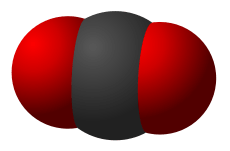Triatomic molecule

Carbon dioxide
Triatomic molecules are molecules composed of three atoms, of either the same or different chemical elements. Examples include H2O, CO2 (pictured) and HCN.
Molecular vibrations
The vibrational modes of a triatomic molecule can be determined in specific cases.
Symmetric linear molecules
A symmetric linear molecule ABA can perform:
- Antisymmetric longitudinal vibrations with frequency
- Symmetric longitudinal vibrations with frequency
- Symmetric transversal vibrations with frequency
In the previous formulas, M is the total mass of the molecule, mA and mB are the masses of the elements A and B, k1 and k2 are the spring constants of the molecule along its axis and perpendicular to it.
Types

Ozone
Ozone, O3 is an example of a triatomic molecule with all atoms the same. Triatomic hydrogen, H3, is unstable and breaks up spontaneously. H3+, the trihydrogen cation is stable by itself and is symmetric.




